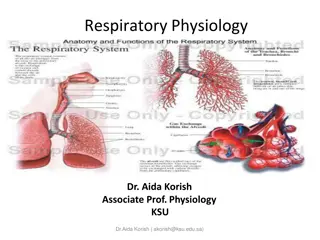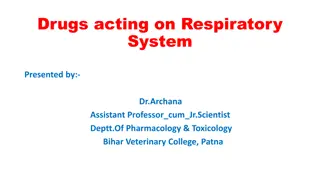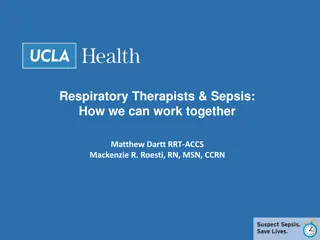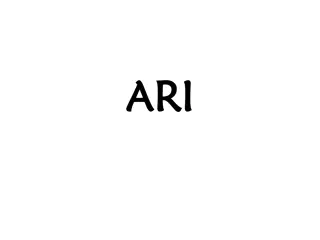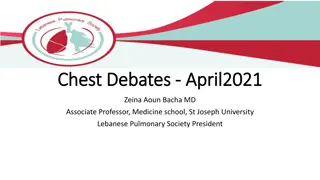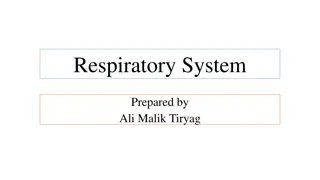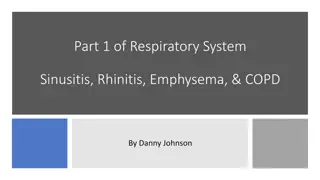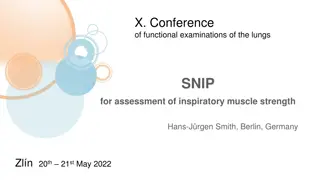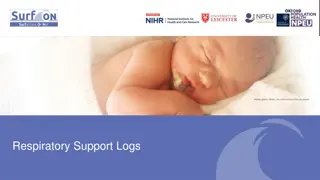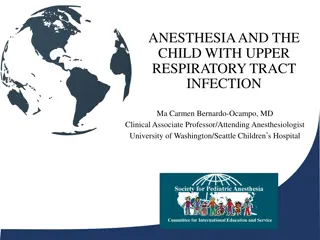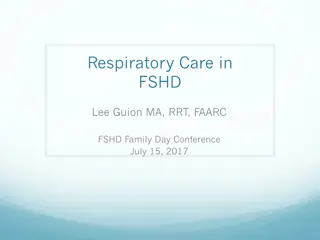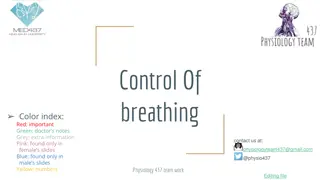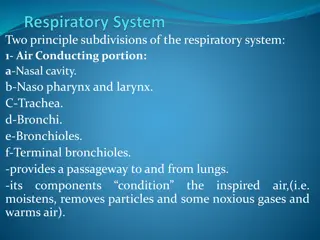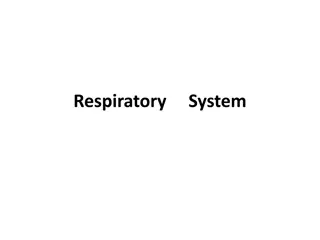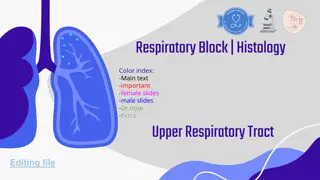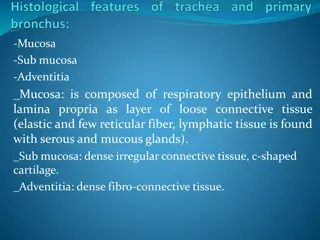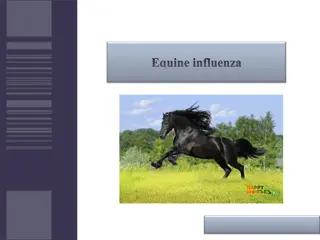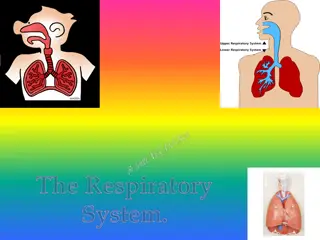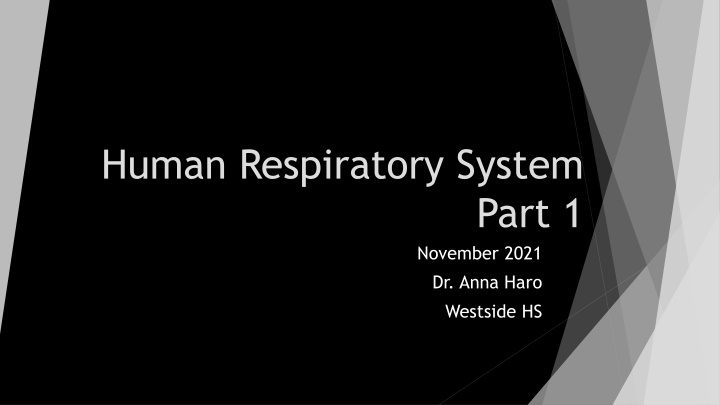
The Human Respiratory System: Anatomy and Functions
Explore the human respiratory system, its anatomy, functions, and physiological processes. Learn about gas exchange, airways, and the importance of respiration in maintaining health. Discover the organs and tissues involved in respiration, such as the mouth, nose, pharynx, and trachea. Dive into the role of the respiratory system in gas exchange, ventilation, and cellular respiration. Uncover the significance of warm air humidification, filtration of harmful substances, and protection against irritants.
Download Presentation

Please find below an Image/Link to download the presentation.
The content on the website is provided AS IS for your information and personal use only. It may not be sold, licensed, or shared on other websites without obtaining consent from the author. If you encounter any issues during the download, it is possible that the publisher has removed the file from their server.
You are allowed to download the files provided on this website for personal or commercial use, subject to the condition that they are used lawfully. All files are the property of their respective owners.
The content on the website is provided AS IS for your information and personal use only. It may not be sold, licensed, or shared on other websites without obtaining consent from the author.
E N D
Presentation Transcript
Human Respiratory System Part 1 November 2021 Dr. Anna Haro Westside HS
LEARNING Objectives TEKS: 130.231.(c)(1)(A, & B) and 130.231.(c)(2)(A, B, C, F, & G) & (3)(B) Students will apply knowledge of human and cellular biology. Students will develop knowledge of the anatomy and physiology of the human respiratory system. Students will compare the different parts of the airways. Students will evaluate the parts and function of the bronchial tree.
Objetivos de aprendizaje TEKS: 130.231.(c)(1)(A, & B) and 130.231.(c)(2)(A, B, C, F, & G) & (3)(B) . Los estudiantes aplicar n conocimientos de biolog a humana y celular. Los estudiantes desarrollar n el conocimiento de la anatom a y fisiolog a del sistema respiratorio humano. Los estudiantes comparar n las diferentes partes de las v as respiratorias. Los estudiantes evaluar n las partes y la funci n del rbol bronquial.
Human respiratory system The main function of the human respiratory system is gas- ______________. Respiratory events include: The movement of air in and out of the lungs, commonly called breathing or ventilation. The exchange of gas between the lungs and blood (external respiration). The exchange of gases between the blood and body cells (internal respiration). The oxygen utilization and CO2 production (cellular respiration).
Other physiologic functions of the Respiratory System The respiratory system: 1. Allows the patient to talk and to _______________. 2. Warms air to match the body temperature and moisturizes it to the humidity level the body needs. 3. _______________ the airways from harmful substances and irritants. 4. Respiration is both macroscopic and microscopic explain what this means.
Human Respiratory System Image from: https://www.h owtorelief.com /respiratory- system-parts- function/ Which lung is larger and why?
What is the anatomy of the human respiratory system? Many different components (organs and tissues) comprise the respiratory system. Start with the airways: 1. Mouth and nose: Openings that pull air from outside your body into your respiratory system. Internal hairs in the nostrils begin to ______________ inhaled air. 2. Nasal cavity is the hollow space behind the nose. This transports air to the pharynx, and the mucous lining helps to filter, warm, and moisten the incoming air. 3. Sinuses: Hollow areas between the bones in your head that help regulate the temperature and humidity of the air you inhale. Also reduces the weight of the skull and adds resonance to voice. 4. Pharynx (throat): Tube that delivers air from your mouth and nose to the trachea (windpipe), which distinguishes air from food/drink entering your esophagus. Located ___________ to the oral cavity and __________ the nasal cavity and larynx.
What is the anatomy of the human respiratory system? 5. Larynx: this is the voicebox and is an enlarged area superior to the trachea. It is the passageway for air and prevents foreign material from entering the lungs and contains the vocal cords. 6. Trachea or the windpipe : Flexible tube and passageway connecting your throat and lungs, specifically the larynx to the _____________ tree. 7. Bronchial tree: Beginning with the bronchial tubes, located at the bottom of your trachea, connecting into the branches of each lung and leading to the alveoli. 8. Lungs: The soft, cone-shaped organs occupying the thoracic cavity (along with the heart), which remove oxygen from air and pass it into your bloodstream. The lungs contain the bronchial tree, the alveoli, blood vessels, connective tissue, lymphatic vessels, and the nerves of the lower respiratory tract.
The bronchial tree Continue work on the do now or on the final exam skit. We will evaluate the anatomy and physiology of the bronchial tree tomorrow.
What are your questions about the respiratory system? Please ask, email, use Remind, or TEAMS. Remember the HON-code? https://www.hon.ch/HONcode/. Even if you cannot find the HON-code stamp, please use the principles of website evaluation. Authority, confidentiality, complementary, attribution, justification, transparency, financial disclosure, and advertising policy (HON-code, 2019).
References https://my.clevelandclinic.org/health/articles/21205- respiratory-system https://www.howtorelief.com/respiratory-system- parts-function/ Shier D, Butler J, Lewis R. Hole s Human Anatomy and Physiology, 9th edition. 2003.

